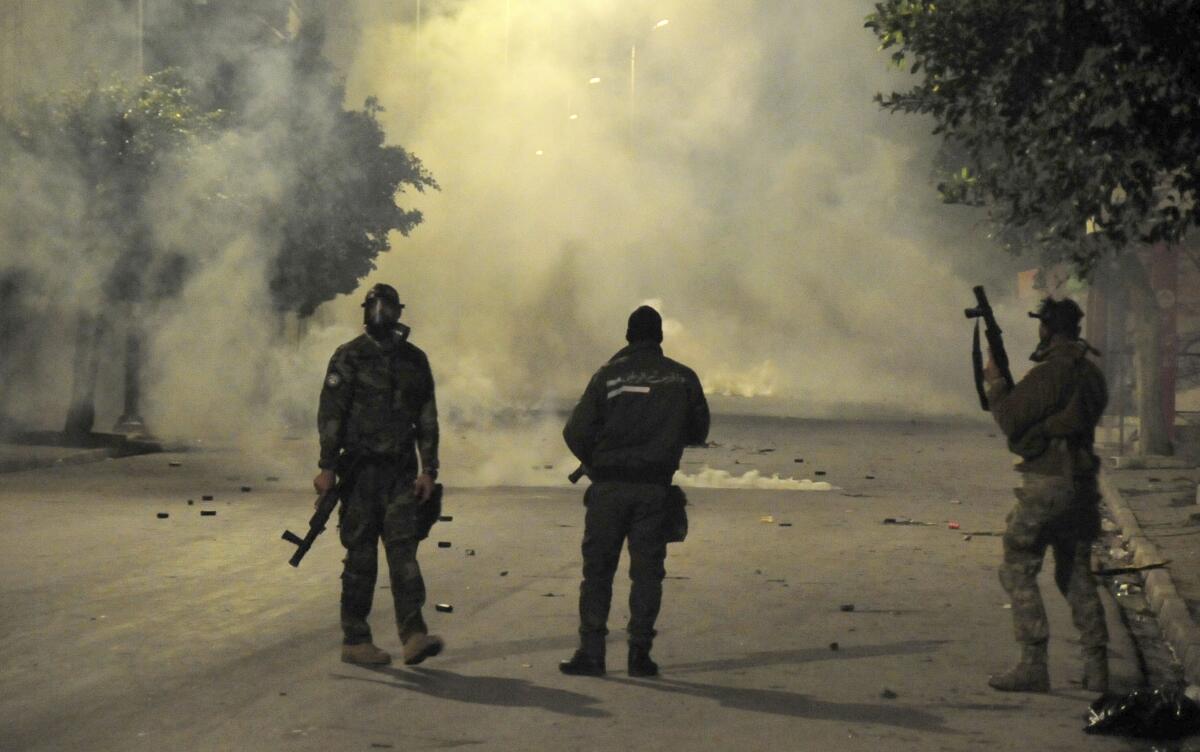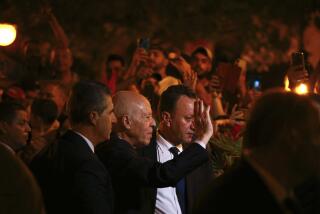Why are youth protests sweeping Tunisia?

- Share via
TUNIS, Tunisia — A growing groundswell of youth unrest, tapping into frustration with the economy, is sweeping Tunisia and worrying its leadership all the way to the top. It is, after all, the country that triggered the 2011 Arab Spring uprisings.
A third of the North African nation’s young people are unemployed, and many are angry about their stagnant fortunes. For several consecutive days, they have taken to the streets in violent demonstrations across the country of 11.7 million — from Tunis, the capital, to the cities of Kasserine, Gafsa, Sousse and Monastir.
The unrest has led to a muscular response from authorities who fear a repeat of the protests that led to the ousting of strongman President Zine el Abidine ben Ali 10 years ago. The army has been deployed in four hot spots.
Here’s a look at what is going on:
What is happening?
Since Friday, protest groups that are growing in size by the day have been out in force every night. They are staging simultaneous, often violent demonstrations in cities.
People have been pelting municipal buildings with stones, throwing Molotov cocktails, looting, vandalizing and clashing with police. The unrest is concentrated in poor, densely populated districts where trust with law enforcement is already lacking.
The army was called in by the government on Sunday night to quell tensions and protect the country’s institutions. Police said hundreds of protesters have been arrested.
What are they protesting?
The precise causes are unclear, but the dire economic outlook of the stagnant country is at the heart of the dissatisfaction.
The protesters, carrying placards with slogans such as “Employment is a right, not a favor,” are angry over the broken promises of democratically elected President Kais Saied and his government, which hasn’t been able to turn around an economy on the verge of bankruptcy.
Ten years after the revolution, whose slogan was “employment, freedom and dignity,” Tunisians believe they have anything but that. A fifth of the country lives under the poverty line, according to the National Institute of Statistics.
Young people don’t remember the repression under Ben Ali and want job opportunities. They’re communicating this common frustration on social media, as young protesters did in neighboring Algeria in 2019, when their movement forced the longtime president out of power.
Why has the pandemic made things worse?
The country’s disparate lockdown restrictions and a nightly curfew since October to contain the spread of COVID-19 have exacerbated tensions.
The pandemic has especially hurt Tunisia’s key tourism sector, once powered by its beautiful historic cities and white sandy beaches.
Flights have been grounded and potential tourists face lockdowns at home amid a general reluctance to travel as coronavirus variants race through nations and continents.
How are authorities responding?
Amnesty International has implored Tunisian authorities to use restraint in calming tensions and uphold the rights of the many hundreds who have been detained, but authorities have been increasingly reliant on the army for help and have used tear gas against protesters.
The Interior Ministry has justified the robust police response as necessary “to protect the physical integrity of citizens and public and private goods.”
Others disagree. The president of the Tunisian Forum for Economic and Social Rights, Abderrahman Lahdhili, said that this approach “is not the most appropriate” and that authorities should instead be looking at the underlying “deep reasons.” Each year, Lahdhili said, 100,000 students drop out of school and 12,000 of them turn to illegal migration, taking to overcrowded smugglers’ boats in a risky attempt to reach Europe. Others, he said, fall prey to being recruited by extremist organizations.
Are Islamist forces behind the protests?
Saied, the conservative president, tried to speak directly to the protesters by making an unexpected visit Monday evening to see them in the popular Mnihla district, near Tunis.
He warned the protesters against extremist Islamist forces “acting in the shadows” who he said are trying to ferment chaos and destabilize the democratically elected government.
It’s unclear whether that is simply a way to shift blame away from his government for the unrest, or whether Islamist forces are really behind the movement. Saied himself is an outsider who won with support from moderate Islamists.
The leader of Tunisia’s influential Islamist-inspired Nahda party, Rached Ghannouchi, has condemned the recent “acts of looting and vandalism.”
More to Read
Sign up for Essential California
The most important California stories and recommendations in your inbox every morning.
You may occasionally receive promotional content from the Los Angeles Times.










